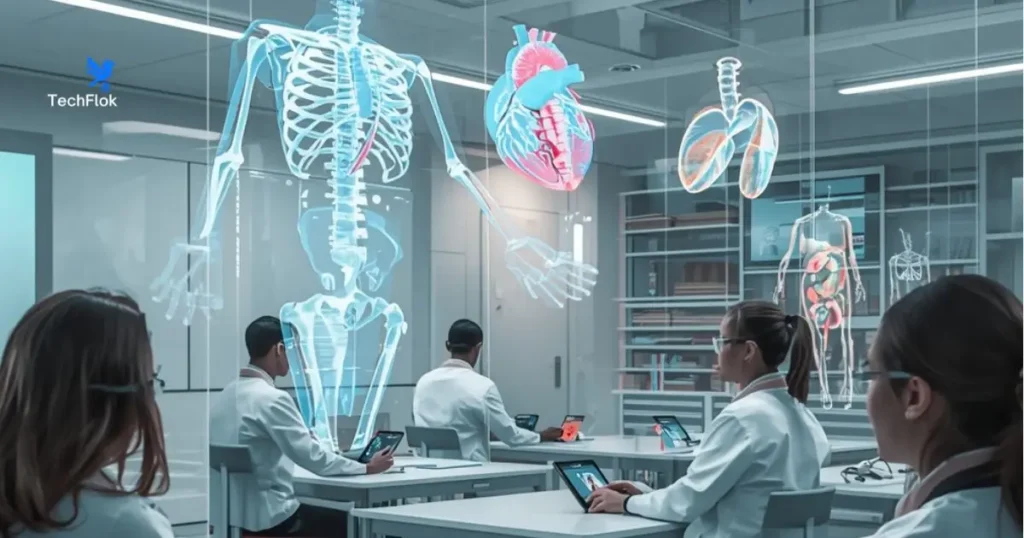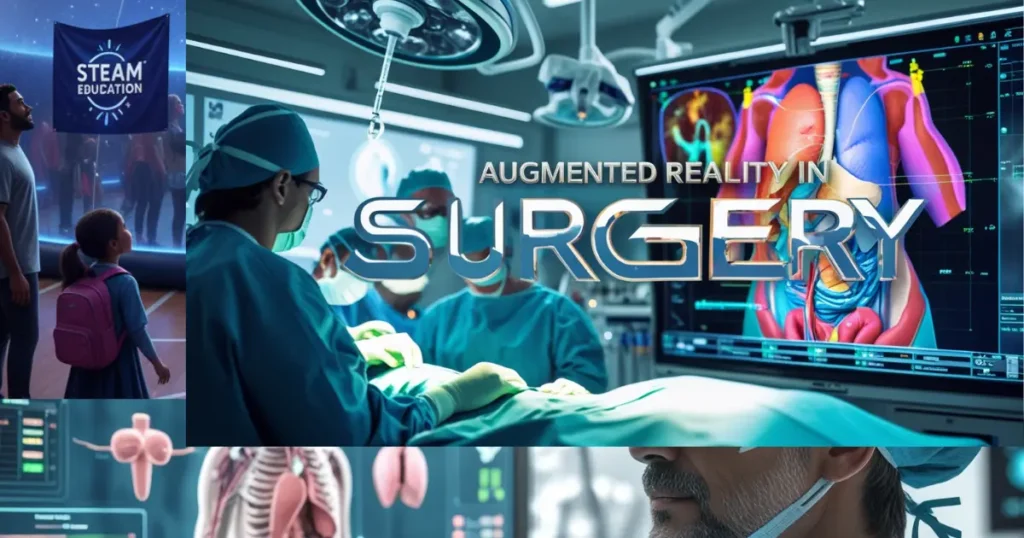
Augmented Reality Hospital technology is revolutionizing the healthcare industry, offering a new dimension of precision and efficiency in medical procedures. From enhancing surgical guidance to improving patient experiences, AR is reshaping how hospitals deliver care. By overlaying 3D images and real-time data onto the physical world, this technology allows surgeons to visualize patient anatomy in exceptional detail. Whether used for medical training or helping patients navigate hospital spaces, augmented reality in hospitals is setting the stage for a smarter, more effective healthcare system.
In this article, I’ll walk you through the incredible ways AR in hospitals is benefiting both healthcare professionals and patients, and how it is set to shape the future of medicine.
AR’s Growing Role in Healthcare
The use of augmented reality in healthcare is no longer a futuristic concept it’s happening now. With AR technology, hospitals can perform surgeries with greater accuracy, train medical staff more effectively, and offer better experiences for patients navigating hospital spaces. From improving diagnostic accuracy to enhancing medical education, AR is paving the way for smarter, more efficient healthcare practices.
What is an Augmented Reality Hospital?
Augmented Reality overlays digital content like 3D images, videos, or real-time data onto the real world, providing enhanced, interactive experiences for healthcare professionals and patients alike. Whether it’s guiding surgeons during surgery or helping patients better understand their medical conditions, AR in hospitals is driving a more precise and efficient approach to healthcare.
Surgical and Clinical Applications of AR in Hospitals

One of the most impactful uses of augmented reality in hospitals is its ability to improve surgical guidance. Surgeons can use AR to view 3D overlays of patient anatomy during operations, helping them make more informed and accurate decisions.
Refine Surgical Precision
Imagine a surgeon performing a complex procedure. Normally, they would rely on 2D CT scans or MRI images to guide their actions. But with augmented reality, these images are projected in 3D, providing a dynamic view of the patient’s anatomy. This 3D visualization ensures that surgeons can navigate critical structures with extreme precision, reducing the likelihood of errors and improving surgical outcomes.
For example, in spinal surgery, AR overlays allow surgeons to visualize the spine’s intricate details, guiding their instruments with unmatched accuracy. This technology is particularly valuable for high-stakes surgeries, where precision is crucial.
Remote Expert Consultation with AR
Another exciting application of AR in surgery is its ability to enable remote consultations. Surgeons in remote or under-resourced areas can be assisted by specialists from around the world. AR technology allows the specialist to provide real-time guidance through live video feeds and digital overlays on the patient’s body, helping the on-site surgeon perform the procedure more accurately. This capability opens up opportunities for expert consultations, even when physical presence is impossible.
Improved Diagnosis and Treatment Planning
When it comes to diagnosis, AR helps doctors visualize complex medical images more effectively. With AR systems, doctors can interact with 3D models of organs, bones, and tissues, improving their ability to detect problems and create detailed treatment plans. This also helps in identifying the best surgical approach, as doctors can see how different treatment options will impact the body in real time.
Vein Finding

Another practical use of AR technology in hospitals is its ability to assist with vein finding. This is especially helpful for nurses and phlebotomists who need to locate veins for blood draws or injections. By using AR overlays, they can clearly see the location of veins, ensuring a more successful procedure on the first attempt and reducing patient discomfort.
Improving Patient Experience
The use of AR in hospitals isn’t just limited to medical staff. The patients also benefit greatly from this technology. Whether it’s understanding their condition or navigating complex hospital layouts, AR offers solutions that improve patient satisfaction and engagement.
Patient Navigation within the Hospital
Hospitals can be confusing places to navigate, especially for patients who may already be feeling overwhelmed. AR navigation apps allow patients to use smartphones or AR glasses to guide them through the hospital, offering step-by-step directions to departments, labs, and doctors’ offices. This helps patients reduce stress, minimize waiting times, and find their way around with ease.
Patient Education
Explaining complex medical information to patients can be a challenge for doctors. But AR makes this process easier. By transforming medical data into 3D visualizations, AR technology helps patients understand their conditions better. For instance, if a patient is being treated for cancer, AR can display a 3D model of the tumor, showing exactly where it is located and how it’s affecting surrounding tissues. This visual aid makes it easier for patients to comprehend their diagnosis and treatment plan.
Pediatric Care
For children, medical procedures can be terrifying. That’s where AR comes into play. By using games or virtual companions, hospitals can make procedures like MRI scans more engaging for children. AR technology can even distract kids by making their experience feel like a fun adventure, significantly reducing their anxiety levels and the need for sedation.
For example, a child undergoing an MRI scan might be guided through the process by a friendly, animated character, helping them feel more comfortable during the procedure.
Improving Hospital Operations
AR is also used to improve the logistics and operations of hospitals. Through real-time data overlays, hospitals can track asset usage, monitor staff performance, and gain insights into patient flow. This data helps hospital administrators make informed decisions that improve overall efficiency.
By visualizing the flow of patients, staff, and equipment, hospitals can optimize their layouts, manage resources better, and improve the patient experience. For example, AR could help hospital staff track where medical equipment is located or provide hospital management teams with information on how many patients are waiting in the emergency room.
Future of AR in Hospitals
As 5G technology advances, AR systems in healthcare will become even more efficient. With low-latency networks, AR devices will provide near-instantaneous data transmission, allowing for real-time, high-quality images to be displayed across multiple devices. This will lead to better communication between healthcare providers and a more seamless experience for patients.
AI and machine learning will also play an increasing role in AR applications. As AR systems integrate more intelligent systems, hospitals will be able to predict medical outcomes, analyze patient data more effectively, and provide more personalized treatments.
Conclusion
Augmented reality is quickly becoming an essential part of modern healthcare. From enhanced surgical precision to improving patient navigation, AR is not just changing the way surgeries are performed but also how patients experience care in hospitals. It helps medical professionals make more accurate diagnoses, provides training opportunities, and even assists patients in understanding their conditions better.
As hospitals continue to adopt AR technology, the future of healthcare looks brighter than ever. If you are part of the medical field or work in hospital administration, now is the time to explore augmented reality solutions. These technologies can not only improve patient outcomes but also help streamline operations and enhance the overall experience for everyone involved.
FAQS
What is augmented reality used for in healthcare?
Augmented reality (AR) in healthcare is used to enhance medical procedures, provide real-time patient data, improve medical training, and offer interactive ways for patients to understand their conditions. It’s also used in surgery, diagnostics, and rehabilitation to improve outcomes.
What is AR in a hospital?
AR in hospitals refers to the use of technology that overlays digital information (like images, data, or 3D models) onto the physical environment. This technology aids in surgical precision, medical education, patient navigation, and more, enhancing both clinical and administrative functions.
How does Coca-Cola use augmented reality?
Coca-Cola uses augmented reality in marketing and promotions, allowing consumers to interact with products through AR-enabled advertisements and packaging. It offers immersive experiences, such as virtual games or product visualizations, to engage customers.
What is an example of AR VR being used in a hospital setting?
An example of AR/VR in hospitals is the use of VR training simulators for medical students to practice surgeries or procedures in a risk-free environment, as well as AR-guided surgeries where surgeons overlay 3D images onto the patient’s anatomy to enhance precision.
What is the difference between AR and VR in healthcare?
AR (Augmented Reality) enhances the real world by overlaying digital information, whereas VR (Virtual Reality) creates an entirely simulated environment. In healthcare, AR helps in surgeries and diagnostics, while VR is primarily used in medical training and therapy.
How is AR used in surgery?
AR in surgery is used to overlay 3D images of a patient’s internal anatomy, such as CT or MRI scans, onto their body in real-time. This aids surgeons in making more accurate incisions, improving precision, and reducing the risk of errors during procedures.


